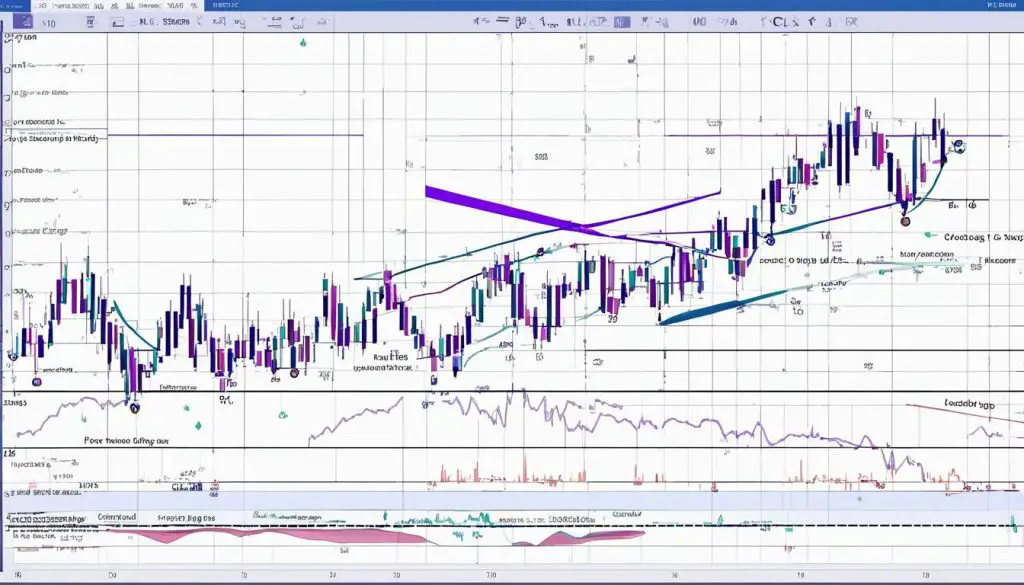Mastering the complex world of financial markets requires not only intuition but also a robust set of tools for forecasting and analyzing market patterns. For traders and financial professionals who integrate technical analysis within their strategy, an Elliott wave cheat sheet has proven to be a vital asset. This tool is built upon the foundation of the Elliott Wave sage, which aims to decipher and quantify the recurring wave patterns embedded in market price movements.
With a keen eye on trading psychology and an understanding of wave mechanics, market participants who utilize the Elliott wave cheat sheet can anticipate probable market moves and calculate trading levels based on elliott waves. In the dynamic dance of the markets, being equipped with the insights provided by the Elliott Wave theory can be the difference between thriving and merely surviving the waves of change.
Understanding the Elliott Wave Theory
At the core of forecasting market trends, the Elliott Wave Principle stands as a pivotal framework in technical analysis, incorporating elements such as market psychology, investor sentiment, and price action. A key assertion of this theory is that collective investor behavior follows a predictable rhythm, shaped by alternating waves of optimism and pessimism.
Basics of Elliott Wave Principle
The Elliott Wave Principle observes that market trends and patterns emerge from the ebbs and flows of investor sentiment, which itself takes form in discernible waves. Each wave is a response to the collective psychology of market participants, and understanding these psychological undercurrents is critical for traders. Focusing on the technical analysis of these patterns allows for a strategic approach to navigating market intricacies.
Psychology and Patterns in Market Trends
Market psychology functions as the main catalyst in the creation of Elliott Wave patterns. When analyzing market trends, one can observe that sentiment peaks often align with market highs, while lows in sentiment are consistent with market troughs. As investors ride the waves between fear and greed, each wave in the Elliott model provides unique insights into potential reversals or continuations of market trends.
These insights are best understood through the lens of investor sentiment. In periods where negative news is prevalent, the first wave of a bullish trend might emerge, ironically underpinned by bearish sentiment. As this sentiment begins to shift, subsequent waves provide a more nuanced view of market psychology, allowing investors to anticipate key turning points driven by collective emotional states.
To illustrate the practical application of these principles, consider the contrasting dynamics between two critical phases:
- Wave one might coincide with negative fundamental news and bearish investor sentiment.
- Wave two often attempts a retest of prior lows, signifying a brewing change in investor confidence despite persisting negative outlooks.
The Elliott Wave Principle lets us parse price action not only through peaks and troughs but also through the subtleties of volume and momentum, seamlessly blending the science of technical analysis with the less tangible but equally powerful forces of market psychology.
Educated speculation based on Elliott Wave analysis affords traders a level of foresight into investor behavior, empowering their decision-making with a deeper comprehension of the interplay between market trends and the waves of investor sentiment that shape them.
| Wave | Sentiment | Price Action | Volume Trend |
|---|---|---|---|
| 1 | Bearish | Initial rise | Low to moderate |
| 2 | Neutral to bearish | Retest of lows | Decreased |
| 3 | Bullish | Strong rise | Increasing |
| 4 | Neutral | Consolidation | Varies |
| 5 | Highly bullish | Climax | Divergent |
Deciphering the Elliott Wave Pattern
At the core of technical market analysis, the Elliott Wave pattern proves to be an invaluable model for traders looking to predict market trends. This pattern is composed of a structured progression that typically includes five impulse waves, which move with the underlying trend, and three corrective waves that go against it. The recognition of these wave patterns is foundational in anticipating possible shifts in market momentum, indicating either a reversal or continuation of the trend at hand.
The distinct sequence of impulse and corrective waves is not limited to a single time frame but can appear across various scales, which is a testament to their fractal nature. This means that patterns identified on a small scale can often be seen repeating on a macroscopic level, and vice versa. Investors who successfully identify and understand these waves are equipped to make strategic decisions, aligning their trades with the inherent rhythms of financial markets.
To distill the complexity of the Elliott Wave pattern, it can be helpful to view the typical wave formations in a tabulated format, outlining the characteristics of each wave type:
| Wave Type | Direction | Characteristics | Typical Market Sentiment |
|---|---|---|---|
| Impulse Wave 1 | With the trend | Begins the movement, often unnoticed | Negative (start of optimism) |
| Impulse Wave 2 | Against the trend (corrective) | Retraces but doesn’t exceed Wave 1 | Mixed (prevailing skepticism) |
| Impulse Wave 3 | With the trend | Longest and most robust wave | Increasingly positive |
| Impulse Wave 4 | Against the trend (corrective) | Typically shallower than Wave 2 | Optimistic but cautious |
| Impulse Wave 5 | With the trend | Final push, exhaustion visible | Highly positive (peak euphoria) |
| Corrective Wave A | Against the trend | Starts the correction, often steep | Turning negative |
| Corrective Wave B | With the trend | Counter-reaction, misleading calm | Falsely positive |
| Corrective Wave C | Against the trend | Ends the correction, often impulsive | Bearish confirmation |
This table highlights the interplay between the impulse waves and corrective waves, offering clarity to the alternating patterns of market behavior. By recognizing these waves in real-time, traders are better positioned to execute transactions that capitalize on upcoming market turns. Indeed, the art of deciphering the Elliott Wave pattern is one that combines precise technical insight with an understanding of trader psychology, ultimately becoming a cornerstone of sophisticated market analysis.
Analyzing Impulse Waves and Market Sentiment
Impulse waves are like the rhythm of the markets, pulsing with the heartbeat of trader sentiment. Success in trading with confidence hinges upon understanding these patterns, which transition from market pessimism to optimism, revealing deeper insights into investor emotions and market mechanics. Acknowledging the intricate link between impulse waves, market sentiment, and volume can lead to astute predictions and smarter trading maneuvers.
From Pessimism to Optimism: Phases of Impulse Waves
The evolution of impulse waves begins stealthily with wave one, typically missed by most as pessimism reigns supreme. As the waves progress, market sentiment experiences a transformation. From the initial unnoticed waves amidst overwhelming bearish sentiment to the climactic peak of optimism at wave five, traders witness an entire spectrum of investor emotions. This progression is not solely a matter of sentiment; each phase reflects varying levels of confidence and caution, impacting how and when investments are made.
The Significance of Volume and Corrections in Impulse Waves
Market volume plays a pivotal role in validating the stages of impulse waves. An uptick in volume may confirm a budding wave one, but it’s wave three that captures traders’ attention with a surge in volume, signaling a strong market move. Identifying these volume patterns, coupled with price corrections, equips traders to capitalize on the dynamic nature of the markets. Whether seeking a strategic entry point during a temporary corrective wave or predicting a potential reversal at the height of wave five’s optimism, an astute understanding of the confluence of volume and impulse waves is essential.
| Wave Phase | Market Sentiment | Typical Volume Movement | Trading Opportunity |
|---|---|---|---|
| Wave One | Pessimism | Moderate Increase | Early Entry, High Risk |
| Wave Two | Bearish Correction | Decrease | Confirm Trend Reversal |
| Wave Three | Turning Optimistic | Substantial Increase | Ride the Strongest Move |
| Wave Four | Consolidation | Decline | Position for Wave Five |
| Wave Five | Peak Optimism | Divergence | Take Profits Before Reversal |
Understanding impulse waves and market sentiment can provide a solid foundation for navigating the financial markets. Recognizing these patterns allows for trading with a deeper level of insight, employing strategic actions based on volume analysis and price corrections to trade with the flow of market sentiment.
Recognizing Corrective Waves in Market Trends
In Elliott Wave analysis, identifying the nuances of corrective waves is vital for grasping overall market trends and steering through the intricacies of trading. These waves, consisting of three categories labeled A, B, and C, are crucial components that run counter to the primary trend and offer insights into impending market shifts. This understanding equips traders with a foresight that is both rare and profitable, particularly when making sense of market reactions and applying technical indicators.
Identifying A, B, and C Corrective Waves
During the initial phase, wave A, despite the prevailing positive news, savvy traders recognize the potential for a trend reversal, as fundamentals may not align with the overly optimistic sentiment. Traders who can decode these signals often uncover opportunities before the broader market takes notice. Wave B typically offers a deceptive sense of security; optimism resurfaces, and prices ascend, which may erroneously be interpreted as a continuation of the bull market. However, it’s wave C that tends to usher in clarity—with its sharper descent and confirmation through market volume enhancements, delineating the bearish outlook and setting the stage for strategic trader response.
Market Reactions and Technical Indicators During Corrections
Integration of signal-rich technical indicators presents traders with the ability to dissect and react adeptly to market corrections. Observing shifts in volume, alongside tracking implied volatility during these corrective waves, can pinpoint sentiment changes and potential trend reversals. Through meticulous examination of these parameters during A, B, and C waves, traders can craft robust trading strategies that align with the comprehensive architecture of market trends, ultimately navigating through the complexities of market cycles with confidence and precision.






